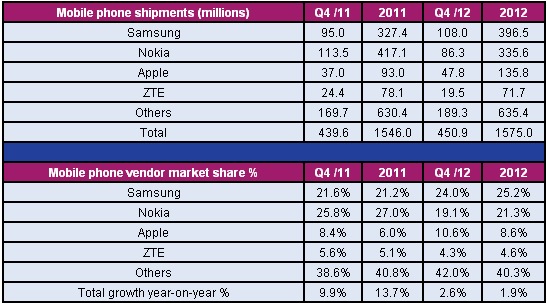Global mobile phone shipments grew a modest 2% annually to reach 1.6 billion units in 2012, according to a report from Strategy Analytics’ Wireless Smartphone Strategies (WSS) service.
“Ongoing macroeconomic challenges in mature markets like North America and Western Europe, tighter operator upgrade policies, and shifting consumer tastes were among the key reasons why global mobile phone shipments grew just 2% annually to reach 1.6 billion units in 2012,” says senior analyst Neil Shah. “Fuelled by robust demand for its popular Galaxy models, Samsung was the star performer, shipping a record 396.5 million mobile phones worldwide and capturing 25% market share to solidify its first-place lead,” he adds. However, Samsung’s total volumes for the year fell just short of the 400-million threshold.
Table. Mobile phone vendor shipments and market share in Q4/2012 (total does not include grey phone shipments).

Nokia’s mobile phone shipments fell 20% from 417.1 million units in 2011 to 335.6 million in 2012. “Nokia faced tough competition from Samsung in developing markets like China, while Apple and others ramped up the pressure in developed regions such as Western Europe,” notes executive director Neil Mawston. “Nokia’s dual-SIM feature phones, Asha touchphones and Lumia handsets have been performing well, but this was not enough to offset a slump in demand for the company’s aging Symbian smartphone platform last year,” he adds.
Apple’s shipments grew 46% to a record 135.8 million mobile phones in 2012, bolstered by solid demand in North America and Asia. “Apple’s launch of the iPhone 5 in Q4/2012 was a success as volumes ramped up in dozens of countries worldwide, but negative media coverage of the model’s new integrated maps service and supply chain challenges cast a slight shadow over the launch,” comments analyst Linda Sui.
Also, ZTE captured 5% share of the mobile phone market in 2012, as its shipments fell 8% from 2011. This was partly because of heightened competition from rivals such as Coolpad and Samsung in core markets like China and Western Europe.





